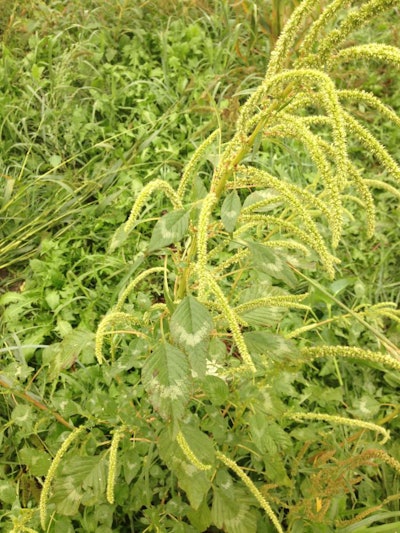
Contaminated animal feed linked to large outbreak of Palmer amaranth on North Dakota farm
Officials in North Dakota are calling for increased vigilance after discovering a large infestation of Palmer amaranth tied to the use of contaminated animal feed.
State officials first detected Palmer amaranth in North Dakota in 2018, with at least one of those initial cases tied to contaminated animal feed. Two years later, Tom Peters, an extension agronomist with North Dakota State University, said the state is facing its largest outbreak yet.
As of mid-September, Peters said the state had confirmed four infestations of Palmer amaranth in North Dakota. One of the infestations is likely the largest to date, although Peters said officials are still tabulating the total acreage.
“We think we still have control,” he said, “but in earlier cases we were able to go out and a group of people could clean things up. This one’s going to be more substantial. I think it’s going to take several seasons to clean it up.”
Palmer amaranth is a noxious weed thought to be native to the American southwest. The weed is capable of growing several inches per day, has developed resistance to many common herbicides, and each individual plant can produce a quarter to a half million seeds, allowing the weed to spread exponentially once introduced to a new area.
Although Palmer amaranth is a fact of life for farmers in other states, Peters said North Dakota has declared the weed “public enemy No. 1” out of fear that it could decimate local grain production.
“North Dakota doesn’t grow the highest yielding corn or soybeans,” Peters said. “Our yields are more modest. Our return to our producers is more modest. So, increasing the weed control cost … we believe it represents a cost that might not be feasible to still be profitable as farmers.”
The seeds can spread in wildflower or cover crop blends, on farm equipment, or may be spread by birds, Peters said. But in the case of this year’s large infestation — and previous outbreaks — officials believe contaminated animal feed may be to blame.
Peters said screenings used as animal feed on that farm were found to contain “a substantial number” of Palmer amaranth seeds. Grain and seed screenings from states where Palmer amaranth is already established may contain the weed’s tiny seeds, leading some states to mull banning the use of certain screenings in animal feed.
Once the screenings become contaminated, Peters said officials believe the seeds remain viable after passing through animals’ digestive tract. If the contaminated manure is spread on cropland, the weed can establish itself rapidly.
“This particular husband-and-wife team really didn’t realize the severity of the weed problem they had introduced on their farm,” Peters said. “To them, it was just weeds and maybe they’re getting bigger, but they’re just weeds. It didn’t take our team more than five minutes to realize this was indeed Palmer amaranth, and it was a very substantial infestation based on the weeds around the feed lot and borders of some of the fields we looked at.”
Peters said screenings sold as animal feed should be tested to determine if they contain Palmer amaranth if they are sourced from regions where the weed is established. He cautioned animal producers against purchasing untested screenings.
“If you’re not getting answers, to me that represents a pretty substantial risk,” Peters said. “To me, personally, that would impact if I would elect to purchase those products.”
Peters similarly warned against sourcing manure from feed lots or operations where contaminated feed may be in use.










